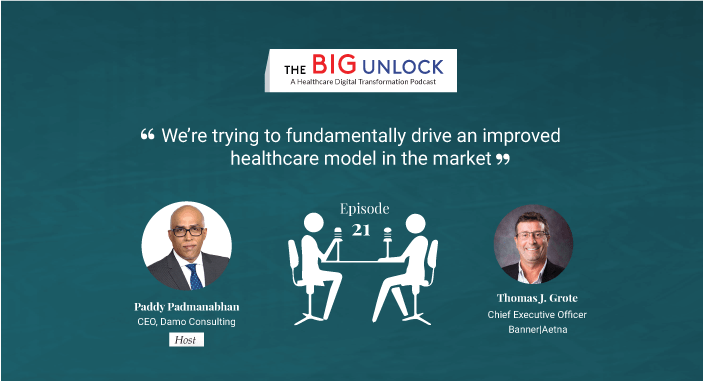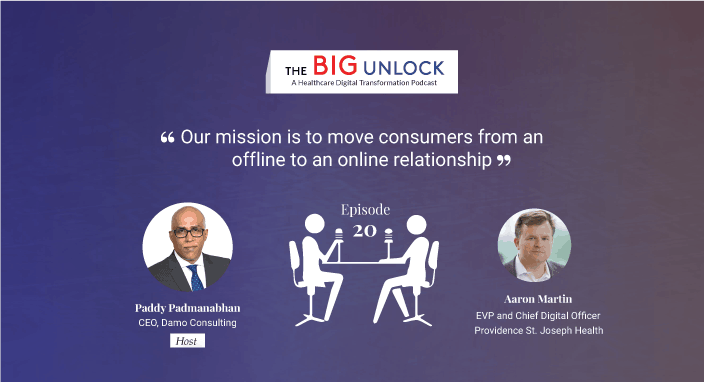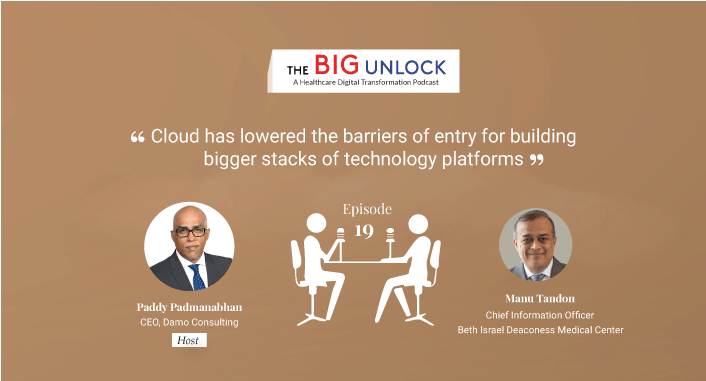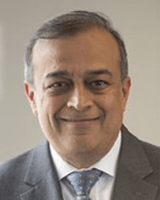Episode #21
Podcast with Thomas J. Grote, Chief Executive Officer, Banner|Aetna
 Hosted by Paddy Padmanabhan
Hosted by Paddy Padmanabhan 
In this episode, Tom Grote discusses how Aetna and Banner Health’s relationship evolved from an ACO into a new commercial joint venture – Banner|Aetna – and how with a shared vision they are improving the primary care model to transform the healthcare market in Arizona.
The collaboration between a leading regional health and a national health insurer in a 50:50 joint venture helps develop and deploy new technology solutions to improve healthcare outcomes while focusing on keeping costs low. Tom believes that joint ventures such as Banner|Aetna can also accelerate the shift from the fee-for-service model to value-based care. He discusses the incremental benefits of Aetna merging with CVS, their approach to strategic technology partnerships, and sharing of best practices among JVs of Aetna with other health systems.
Tom advises ACO leaders and Chief Population Health Officers to focus on relationships and try to align with partners who share a common vision and believe there is a better way to transform the whole healthcare system.
Welcome to the big unlock podcast where we discuss digital transformation and emerging technologies in healthcare. Here are some of the most innovative thinkers and leaders in healthcare and technology. Talk about how they are driving change in their organizations.
Paddy: Hello again everyone. Welcome back to my podcast. This is Paddy and it is my great privilege and honor to have as my special guest today Tom Grote, Chief Executive Officer of Banner|Aetna which is a joint venture between Banner health in Arizona and Aetna Insurance. Tom welcome to the show.
Tom: Thanks very much. Glad to be on.
Paddy: Thank you. Just to get us started off here Tom. Can you tell us a little bit about how the JV came about a little bit of the history of the Banner|Aetna relationship?
Tom: Sure. Banner Health and Aetna had an ACO arrangement, Accountable Care Organizations relationship for five years. And it was relatively successful and had been able to grow membership together, drive down costs for the members, and improve quality. But there were seemed to be so much more that can be done on trying to improve the healthcare delivery system in terms of the care management approach and the member experience. And you know I think collectively we both felt that the current arrangement did not give us the significant opportunities to really impact that delivery model. So, we had a shared vision about trying to come together and trying to transform healthcare in the market. The joint venture presents some pretty unique opportunities, while an ACO relationship provides incentives for improving efficiency and quality. It doesn’t necessarily allow you to do traumatic changes to the way healthcare is delivered. And we felt that the joint venture platform provided that appropriate structure. The key being that we own the insurance company together. So, we’ve formed a new insurance company owned half by Banner and half by Aetna which creates full alignment and the financial incentives of the two organizations which is really addressing one of the key ongoing issues in healthcare delivery. And working together it gives us an opportunity to be more bold about how we try to change healthcare and the care management model. You know one of the things we do as we turn over utilization management responsibilities to Banner health. Under normal arrangement you know people would not understand that concept because it would look like the fox watching the hen house. But as a joint owner of the insurance company founders want to do what’s in the best interest of our members and delivering quality and efficient care. So, it enables us to move initiatives forward like getting care decisions closer to the delivery of the care and allow for more significant changes in the way we deliver healthcare. So that’s a key aspect of why that joint venture was formed and the key advantages of it. Another area is in just technology and innovation. Together working with a delivery system and the insurance companies we can develop new solutions and new approaches you know relatively quicker, actually quicker than probably both of our parent organizations. So, it provides a really unique platform to try new approaches to care delivery and member experience approaches for the people here in Arizona. So that was the foundation for why we ended up evolving our previous relationship from the accountable care organization into a joint venture.
Paddy: And we will explore some aspects of how you’re using technology, data, analytics, and innovation as we go through this conversation. Just to round out one quick question on the
structure of the JV itself. Aetna is a part of CVS, so is it fair to say that now the joint venture is 50 percent owned by CVS and the other 50 percent is by Banner health?
Tom: Yes, that would be accurate. Yeah, we’re still Banner|Aetna. But that’s true as the parent organization, CVS is the half owner of the company.
Paddy: Does anything change for the JV and its mission as a result of that?
Tom: I think there are opportunities with the CVS assets in Arizona to integrate those into our care delivery model and provide additional access points and opportunities for us to better manage our members and their product additions together. So, there will be many clinics and eventually health hubs in the markets that are very accessible to our members and they’ll provide additional access points to our members. I think the key with this though is that it’s a connected experience and CVS just becomes part of our healthcare delivery ecosystem here in the markets. So, the encounters are all captured, the data is shared and we’re able to coordinate that overall member experience.
Paddy: Thank you for that. That’s very helpful. So, Banner|Aetna’s mission is to provide superior quality at lower cost. And I imagine that what it essentially means is managing healthcare at a population level. So, what metrics do you typically track in pursuit of your mission. And how do you benchmark performance against your peer group?
Tom: We typically start with best practices from around the country but then you have to adjust for local market nuances. Arizona is actually a lower cost, lower utilization state relative to some of the other states. So, in that regard you have to adjust downward or upward on some of the goals that you set for the joint venture. But we monitor the performance of the joint venture on a monthly basis against the established benchmarks that we put forth and collectively meet with Banner on the monthly basis to review how our performance is tracking both from an efficiency and quality perspective and then implement programs around initiatives that we want to drive improvements in either our quality standards or in the efficiency and the way we deliver care. So, I think it’s one of the unique things about the joint venture is that we are coming up with solutions together to challenges that we see or opportunities that we see to improve the way we can deliver care on behalf of our members.
Paddy: So, in this podcast we talk a lot about digital health. The use of data analytics and emerging technologies. Can you maybe share with us what kind of technologies you alluded to how you’re using technology to drive improved healthcare outcomes in an improved patient experience? Can you maybe give us some examples and talk to us a little bit about how you’re using technology to drive your mission?
Tom: Absolutely. We just introduced an exciting new virtual care platform for our members as of July of this year. We had evaluated the historical approaches and did not find them to be driving the kind of utilization and member satisfaction that we would expect out of a virtual care solution. So we went to market and evaluated 15 different companies in the virtual care space and found this organization called 98Point6 that delivers an incredibly convenient and low cost approach to primary care and they leverage a text-based system that leverages artificial intelligence upfront to gather information and then a board certified doctor comes on the back end to develop a treatment plan, order prescriptions, order labs whatever is needed to help support the member’s health. And the amazing thing about this is that the structure utilizing that technology enables
them to deliver it at a very affordable basis. And so, for our members it’s no cost to access this primary care physician service that they’re in a PPO and it’s only five dollars that they’re in a HSA. So, we are extremely excited about this new offering and it provides incredible convenience at very affordable rates. So that’s the kind of thing that we stood up in less than nine months that would take a much larger organization much longer to deliver. You know another example is you know we do try to leverage capabilities of our parent organizations. And so, there is the Aetna Attain app that was jointly developed with Apple and Aetna to deliver a new Apple watch app that’s more than just tracking physical activity. It’s looking at the health history of the members, understanding the members, understanding their overall health goals. Not just about activity but about sleeping better, or eating better, and providing incentives to members to improve on those areas that the member wants to be most focused in on and reward them for those capabilities. So those are two examples of where we are implementing technology to improve the member experience or improve the health status of our members.
Paddy: Those are actually great examples of what we would call digital health solutions. It seems to me that if I look at what’s going on in the marketplace there is a lot of activity in the whole primary care experience space with both traditional and non-traditional players in healthcare coming up with chatbot enabled symptom triaging or just you know mobile enabled healthcare services and so on and so forth. It seems to me like the activity level in this space is very high and it seems that it’s all eventually going to help healthcare consumer gain better and quicker access to care at a time of their choosing and possibly at a very affordable price as well. Do you agree with that assessment Tom?
Tom: Yeah, I agree with that 100 percent. And I think you know going back to CVS. We’re now in a situation that you know our members can access care at low cost through the virtual care solution with 98Point6. They can go to a mini clinic at CVS or go to a primary care physician whatever is most convenient to them and we just want to provide as many convenient and affordable access points as we can on behalf of our members. Because you know members want to access care differently and especially when you look at the millennials and their heavy use of their phones for accessing most services.
Paddy [00:11:02] So one important aspect of enabling these digital health solutions is obviously the data and the analytics. I mean you referred to that a couple of times. You know you’ve now got access to the Aetna insurance claim data and member data, you have access to the local population’s health history through the Banner health relationship and possibly more through the CVS connections now as well. Can you talk about how you’re able to leverage the combined power and potential of data from these multiple sources about your specific member population and also what kind of guard rails do you need to have in place when you’re doing that?
Tom: Yes. So, you know connecting all those data points is obviously incredibly important. And so, we actually engaged with IBM Watson to help develop a joint database so it’s pulling in information from the claims, the lab work, the pharmacy data and combining it with the clinical information that Banner is providing. And I guess the key there is merging the records, so you make sure they’re consistent records of the same person so that you get a more comprehensive view of your members. And ultimately, we haven’t deployed it yet but we will also be layering on top of that social determinant information so that we can better connect and identify with our members. And so, I think the key with that is now taking this information that’s going to be more real time than looking at just claims data so that we can better manage the population going forward. And so that’s the focus of this relationship with IBM Watson is providing that
comprehensive more real time database so that we have a better view of our full members information. As you said you know especially when we’re done with health information you know the guard rails and the protections are really important and working between IBM, Aetna, and Banner who are all heavily vested and member protections all the appropriate guardrails are in place and then only those that need to see the data have access to it.
Paddy: Talking specifically about your population which is in a specific part of Arizona. Are there any population level aspects that you need to consider when trying to promote the use of digital health like demographic difference? You mentioned millennials for instance. Is your population skewed in one way or other to a certain kind of demographic that you have to take into consideration? I’m curious because digital adoption rates vary from state to state from region to region and demographics has a lot to do with whether your population is even going to use those tools.
Tom: Right. Yeah, I think generally we are focused on commercial populations. And so, I would say that we have a very good cross-section of the population of Arizona. I think the unique aspect of Arizona is that about 30 percent of the population is Hispanic. And from that perspective there’s a higher prevalence of diabetes in that population. And so, you know one of the things that we’re doing is recognizing the makeup of the population of the state is working closely with Banner to develop a market leading diabetes program. And that is in development. So, there’s a lot of work to develop on that but it’s responding to that population and making sure that we are doing what we can to improve the whole health of the population here in Arizona.
Paddy: Banner|Aetna is not the only JV that Aetna has. You’ve got multiple JVs. When I looked it up you have one with Sutter health, with Allina Health and a couple of others as well. Do you get the opportunity to share best practices, learn from what they’re doing especially around things like innovation and so on? Can you tell us a little bit about that?
Tom: Yes I think it’s really important in each of these JVs have different initiatives that they’re pursuing and it’s you know it’s locally based which is how healthcare should be managed. But we have a JV operations team at Aetna that helps to support improvements to the member experience and support operations across all five JVs. So, they are a single entity that is able to see initiatives going across the JVs and recommend opportunities to bring forth new initiatives to the other joint ventures. Our C-suites teams have frequent calls with one another, and we talk a lot about what we’re working on, what are the key initiatives are and so forth. And to date we’ve had a number of different initiatives that have been shared by multiple joint ventures. So, we recently introduced a new member welcome kit which number of the JVs implemented. We’re putting in a new IVR enhanced persona and 98Point6 is another example of initiatives that are being deployed by multiple joint ventures. So, we’re constantly trying to communicate with one another about different programs initiatives that are going on to see if there are things that we would like to deploy as well. And a lot of our focus is on that member experience. What is it we can do to streamline that process for the members as they go trying to access healthcare.
Paddy: So the focus is overwhelmingly on the member experience it sounds like.
Tom: Yeah, it’s the biggest challenge in our industry. We have both sides of the equation when you have the delivery system and the insurance company working together it provides the best platform to try to really come up with a solution that can change that and improve upon going forward.
Paddy: Now that’s a perfect segue to what I was also asking next which is kind of the flip side of the coin in some ways and this might sound a little provocative or controversial but payers and providers are historically not collaborated as much as one might expect. Based on your experience and that you’ve been a part of this JV and you’re working very closely with the provider. What are some of best practices? What does it take to make a JV like this work now?
Tom: The true shared vision is absolutely critical that the delivery system understand that fee-for-service is not here for the long term and that the ability to manage populations is going to be what the future holds is a critical aspect upfront because as you go through that transformation from just value-based care and to owning an insurance company you are taking a more drastic movement away from fee-for-service and more focused on population health. So, the organizations really have to be committed to believing in this new model and take senior management leadership of the two organizations to really push through their organization to help support initiatives within the respective companies to support the joint ventures. There’s so much historical friction between the delivery system in the insurance companies that it’s really important that senior management intervenes and says you know we have to find ways to change the way we work together to improve it for our members. And you know in many regards you have to ask people to go away from their standard metrics and their overalls to rethink how we should interface with one another. And it’s not an easy process sometimes because somebody there is an accounts receivable area you know has a specific goal they’re trying to achieve and you know and they’re very focused on that instead of thinking well maybe if we changed the way we set up our contracts we could eliminate all this behind the scenes work and so forth. So, it’s really important that the two organizations are constantly reinforcing what the JVs are trying to accomplish and that you know it’s going to be critical but think outside the box to come up with new and better ways to transform that healthcare delivery process.
Paddy: That’s well said. Now you mentioned fee-for-service. All indications are that there is a shift that is taking place from fee-for-service to some kind of accountable care model. At the same time the research and the studies also show that this shift is not as quick as some of us might want it to be. I read somewhere that something about 25 cents on the dollar on every healthcare dollar goes through some kind of an alternate payment model. Now whether that number is accurate or gives us a sense of the order of magnitude. Do you care to comment on where we are in that continuum and what do you think it will take to accelerate the shift towards value-based care?
Tom: Yeah, I do think that the joint ventures accelerate that process because it is more than what we’re paying the underlying piece. Under this arrangement on our fully insured business if collectively Banner|Aetna with support of Banner and Aetna are able to control the utilization and deliver more efficient healthcare on behalf of our members which is going to remove people from the hospitals, put them into lower cost settings, and about removing or reducing readmission rates and so forth. Those are shifts to the delivery system. But when you’re in the joint venture together and you are able to create those improved efficiencies. Yes, it is taking revenue out of the health system. But you know they have an opportunity to recover a portion of that through the insurance company now and sharing in the earnings of the insurance company. And so, it does change that perspective. It really is about total cost of care and it’s really about how do we solve this together. I think the joint ventures provide this unique opportunity to really escalate this process and it’s not at this environment where you get that full alignment is this how we can move that process along faster. It is still challenging because there’s always somebody that’s looking at reduced utilization in the hospital and saying well this is impacting our immediate bottom line. But
I think it’s important to have that long-term vision that we are going to continue to move in a value-based care realm going forward.
Paddy: So, Tom we’re kind of coming up to the end of time here. I did have one question for you what advice you have for other ACO leaders and Chief Population Health Officers across healthcare based on your experience and your learning so far.
Tom: I think the key piece is having relationships with organizations that truly share the vision and are committed to it as part of their makeup because that presents the real opportunities to be creative and innovative and the way you can work together. I think our joint ventures are an example of that we are really looking at the whole delivery model how does it work, how can we partner together. The bottom line is what we’ve done historically hasn’t been successful. And we can’t keep going down the same route and if we do that, we’re not going to have improvements in healthcare delivery. And so really trying to align with like partners that believe that there is a better way to do this is critical to drive change in our healthcare system.
Paddy: So, Tom we’re kind of up to the time here. Any concluding thoughts, any final thoughts that you want to share before we conclude the podcast.
Tom: Yeah, I think that I’ve been in this business a long time. I started back in 1987. This opportunity to work with Banner and together on this joint venture has been certainly the most exciting thing that I’ve ever been involved in my career because we look at it as a real opportunity to leave our mark on this industry and find a better improved ways to deliver care on behalf of the people in Arizona. So, it’s an extremely exciting opportunity. And I think when we have the right collaboration, we train organizations to really fundamentally drive an improved healthcare model here in the market. So, it’s definitely a thrilling relationship that we’ve developed here.
Paddy: Thank you. Thank you. That was great and I really appreciate your time today. Tom. It was a great conversation I enjoyed it very much. And I look forward to staying in touch. Thank you again.
Tom: Thank you so much.
We hope you enjoyed this podcast subscribe to our podcast series at www.thebigunlock.com and write to us at [email protected]
About our guest

Thomas J. Grote leads the Banner|Aetna joint venture as Chief Executive Officer. He is responsible for building a sustainable model of healthcare enhanced by a distinctive member experience for joint venture members throughout Arizona. He is also responsible for enhancing product offerings while lowering costs, creating a clinically integrated network, and growing Banner|Aetna’s footprint throughout the state. Tom is accountable for the overall success of the health plan, and works to leverage the strengths of each partner to create an improved member experience within the Arizona healthcare delivery system. Prior to being named CEO of Banner|Aetna in 2017, Tom held various sales and profit & loss management roles throughout his 30-year career at Aetna. He was also a key contributor in the development of Aetna joint ventures in Northern Virginia and Northern California. Tom holds a Bachelor’s degree in finance from the University of Notre Dame and has obtained his Certified Employee Benefits Specialist designation.
Recent Episodes
About the host
Paddy is the co-author of Healthcare Digital Transformation – How Consumerism, Technology and Pandemic are Accelerating the Future (Taylor & Francis, Aug 2020), along with Edward W. Marx. Paddy is also the author of the best-selling book The Big Unlock – Harnessing Data and Growing Digital Health Businesses in a Value-based Care Era (Archway Publishing, 2017). He is the host of the highly subscribed The Big Unlock podcast on digital transformation in healthcare featuring C-level executives from the healthcare and technology sectors. He is widely published and has a by-lined column in CIO Magazine and other respected industry publications.
Connect







